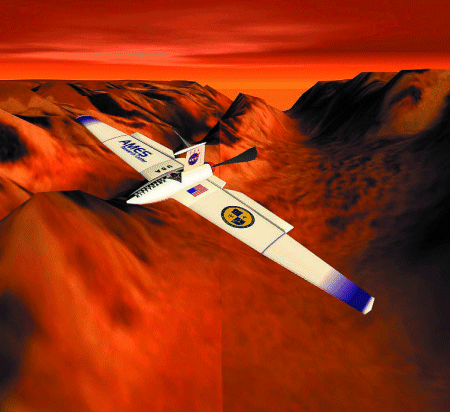NASA hopes to deploy a fleet of small gliders to explore parts of Mars that other spacecraft cannot reach
Swooping through Mars' own grand canyon, the Valles Marineris, would be the ultimate hang-gliding trip. The first aircraft to make that tantalising journey could be the $40 million Mars Airplane, which NASA hopes to launch in 2003.
The aircraft is part of the new Micromission programme being developed by NASA to enable multiple small payloads to be carried piggyback on larger planetary spacecraft.
The Mars Airplane is intended to demonstrate technologies to enable the maximum amount of Mars data to be returned to earth, according to NASA's Office of Space Science. "We intend to select the scientific investigations and probably the entire aeroplane/payload/entry system through competitive peer review," says NASA. A wide range of scientific missions could be flown on the aircraft, from high-resolution imaging to monitoring Martian weather.

Although the exact specifications of the Mars aircraft have yet to be determined through competitive bids, the basic guidelines call for a craft with a 2m (6ft) wingspan and a maximum weight of 20kg (45lb). The mission could involve either three unpowered, microlight-class, vehicles or a single glider powered by a small hydrazine motor.
NASA says the Mars Airplane will be "analogous" to the Mars Pathfinder which, with its Sojourner rover, landed on the Red Planet in July 1997. The Pathfinder kicked off a series of Mars flights that may culminate in Martian samples being returned to earth in 2005.
NASA is putting forward a $9 million funding request for the Mars Airplane project in its fiscal year 2000 budget proposal. The organisation hopes the aircraft will be launched in 2003. Ideally, the rest of the $40 million price tag would be funded incrementally in fiscal years 2001 and 2002. If funding is delayed, the first mission could be pushed back to 2005.
If a three-glider project is adopted, the aircraft would be deployed from a main lander craft at 12km, and would fly 120km during 20min flights, propelled by the high Martian winds and updraughts. The powered glider concept would involve a craft deployed at 15km, using a parafoil. It would then deploy its wings and propeller to fly a 750km circuit at 600km/h.
Potential missionsThe Mars Airplane's potential missions could be tailored for large-scale or detailed explorations. It could provide regional coverage at moderate resolution, filling the gap between the wide coverage of orbiters and the small area - but high resolution - coverage of landers.
Alternatively, it could provide regional imaging and high-resolution spectral data and enable geophysical investigations to probe the subsurface of a large region. Valuable measurements of atmospheric conditions over a wide altitude range could also be provided, as well as a close scrutiny of potential future landing sites.
NASA says the Mars Airplane could be dedicated to specific tasks. Among the possibilities are very high-resolution imaging of a large area, allowing detailed geological surveys, and high spatial resolution spectroscopy studies.
Other missions could include temperature and pressure measurements over a variety of altitudes and regions, and magnetic and electric field measurements, to give an insight into subsurface structure or even the presence of subsurface water or ice.
Detailed gravity measurements could be conducted to provide insights into subsurface structure. "Alternatively, the mission could provide a synthesis of all these disciplines to assist the selection of landing sites in the future," says NASA.
The Valles Marineris, four times deeper and six times wider than the USA's Grand Canyon, has not yet been finalised as the target, but is potentially the most exciting prospect - particularly if the glider provides almost real-time coverage via the Internet as the Mars Pathfinder did in 1997.
The 4,000km-long Valles Marineris, named after the US Mariner 9 spacecraft which photographed it in 1971, could offer a magnificent setting for a project originally called Kitty Hawk to celebrate the centenary of the first flight by the Wright brothers in 1903.
The Martian Kitty Hawk was born as a much larger project, the $246 million Mars Airborne Geophysical Explorer (MAGE), proposed last year. The MAGE was chosen by NASA for the Discoverer programme, but did not make the shortlist of five picked to compete for its Discoverer 7 and 8 missions (Flight International, 25 November-1 December, 1998).
As now conceived, the Mars Airplane would be part of a mission flown with France and other international partners in 2003. The mission - to be launched by a European Arianespace Ariane 5 - may be the European Space Agency's French-led Mars Express, which might also carry a UK-built lander called the Beagle. That project has not yet been cleared, however. Alternatively, the mission could become an all-NASA affair, with French space agency CNES providing the Ariane 5 launch commercially.
The 2003 Mars Airplane mission would also fly with a small, $40 million Micromission telecommunications-relay orbiter, which may be built by commercial space exploration company SpaceDev, based in San Diego, California. The craft would complement the NASA orbital communications network being provided by larger Mars Surveyor programme orbiters.
A CNES/NASA Mars sample return mission planned for 2005 will carry four Micromission payloads, proposals for which include monitoring orbiters and surface micropenetrators.
Source: Flight International























